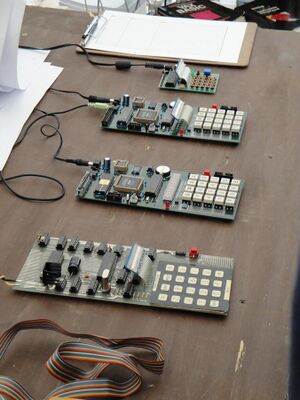Engineering:MK14
 MK14 (foreground) with modern reproductions behind | |
| Also known as | MK14 |
|---|---|
| Manufacturer | Science of Cambridge |
| Type | computer kit |
| Release date | 1977[1] |
| Introductory price | £39.95 GBP (£250; $321 at 2024 prices) |
| Units sold | 15,000[2] |
| CPU | National Semiconductor SC/MP (INS8060) |
| Memory | 256 bytes of RAM (expandable to 640 bytes) + 512 bytes of ROM |
| Display | 8 or 9 red light-emitting diode (LED) seven segment display |
| Input | 20 key keyboard |
| Successor | ZX80 |
The MK14 (Microcomputer Kit 14) was a computer kit sold by Science of Cambridge of the United Kingdom , first introduced in 1977 for £39.95. The price was very low for a complete computer system at the time, and Science of Cambridge eventually sold over fifteen thousand kits.
History
Design
From 1974, Ian Williamson was working at the engineering firm Cambridge Consultants Ltd (CCL) where he repeatedly tried to interest the firm in producing microprocessor-based arcade games. With no success there, he began to consider designing a small computer kit for the growing number of engineers interested in microprocessors. He decided it would have to cost around £50-£60. In 1976, Bywood Electronics released the SCRUMPI kit at £56, based on the National Semiconductor SC/MP. But the SCRUMPI lacked a keyboard or display, it instead included circuitry to connect it to a computer terminal, which were very expensive.[3]
Williamson decided to design his own version to address these issues. National had an evaluation system known as the IntroKit that included the SC/MP processor, 256 bytes of RAM, and several support chips. Among these was a system that interfaced the board to the KBDKit, a handheld electronic calculator that was used as a basic display and keyboard. But instead of using National's version, Williamson instead used a calculator chip already being used at CCL, and went looking for a very low-cost calculator to replace National's. This led to the use of a bright red Sinclair Cambridge Memory calculator from Sinclair Radionics as the interface.[3]
By this time, in the spring of 1977, Williamson was offered a job at British Leyland, which he accepted. He approached the managers at CCL to take on production of his computer design, but they were uninterested. This led naturally to Sinclair, who already made the calculator he was using and had a long history in selling kits.[3]
Sinclair
Sinclair Radionics had been nationalized and Clive Sinclair was losing control of the company. In 1976 he set up Science of Cambridge (originally as Sinclair Instruments) to recreate Radionics' early mail-order kit success. He handed the company to Chris Curry, who ran the company single-handedly. Their first product was the kit-form Sinclair Wrist Calculator which was moderately successful but relatively low quality. When Williamson approached Sinclair and Curry, they both liked the idea and saw the potential of selling this more advanced kit into the hobby market.[4]
When Curry approached National inquiring about costs for a mass purchase of the SC/MP, National countered by offering them a completely developed computer system based entirely on National's parts. The design combined National's SC/MP Introkit and Keyboard Kit and they offered the resulting design for free, along with some basic software, in exchange for a contract for the parts. Sinclair decided this was a far better deal than what he could arrange using Williamson's design, and Williamson was cut out of further development. Williamson would later be paid £2,000, ostensibly for writing a manual.[4]
It was put on the market at £39.95 plus £3.20 VAT and 40 pence postage and handling. They placed an initial order with National for 2,000 sets, but the low cost resulted in early orders for 20,000. The first systems began to arrive in February 1978, but real production quantities did not begin to arrive for another three months.[5] According to Curry, about 15,000 were sold in total.[4] The name apparently refers to its fourteen components.[6]
Specification
The computer is based around National Semiconductor's SC/MP CPU (INS8060) and shipped with 256 bytes of random-access memory (RAM) and 512 bytes of read-only memory (ROM) as standard. It used an eight or nine red light-emitting diode (LED) seven segment display, there was also optional VDU supporting 32×16 text or 64×64 graphics.[citation needed] Input and output was a 20-key keyboard and reset switch. Cassette-based and PROM storage were optional extras; a sound card was not included but a design for one was provided.[7]
The on-board RAM could be increased in two ways; by the addition of an INS8154N RAM/IO chip providing an additional 128 bytes of RAM along with 16 I/O lines, and also a further 256 bytes by adding two 256 × 4 bit RAM chips giving a maximum of 640 bytes on board. These memory spaces were not contiguous in the memory map. It was possible to connect off-board RAM giving a 2170 bytes total.[7]
See also
References
Citations
- ↑ "Planet Sinclair: Computers: MK 14: Articles: PE 5/79". https://www.nvg.ntnu.no/sinclair/computers/mk14/mk14_pe0579.htm.
- ↑ Smith 2014.
- ↑ Jump up to: 3.0 3.1 3.2 Smith 2014, p. 1.
- ↑ Jump up to: 4.0 4.1 4.2 Smith 2014, p. 2.
- ↑ McAlpine 2018, p. 37.
- ↑ Ashton, James (2023). The Everything Blueprint. Hodder & Stoughton. p. 43. ISBN 9781529394078. https://books.google.com/books?id=X3qoEAAAQBAJ&pg=PT43.
- ↑ Jump up to: 7.0 7.1 Owen.
Bibliography
- Owen, Chris. "Planet Sinclair: Computers: MK 14 Specifications". https://rk.nvg.ntnu.no/sinclair/computers/mk14/mk14_specs.htm.
- McAlpine, Kenneth (2018). Bits and Pieces: A History of Chiptunes. Oxford University Press. ISBN 978-0-19-049612-8. https://books.google.com/books?id=h9B2DwAAQBAJ.
- Smith, Tony (16 January 2014). "Ian Williamson: The engineer who gave Sinclair his first micro". https://www.theregister.co.uk/2014/01/16/archaeologic_ian_williamson.
External links
- Old-computers.com dedicated page, article, pictures, documents and videos
- 1978's Raspberry Pi (MK14) - Computerphile
- MK14 manual
- The Sinclair / Science of Cambridge MK14 Web Site, includes emulator software
- Making a reproduction MK14 – includes original manuals/schematics
 |


